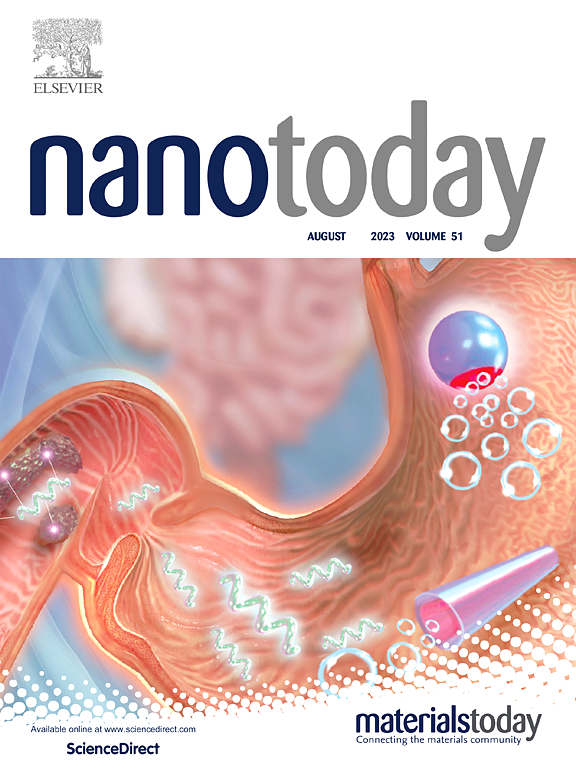氧化胆固醇掺杂仿生肺表面活性剂纳米载体增强肺部疫苗递送
IF 10.9
1区 材料科学
Q1 CHEMISTRY, MULTIDISCIPLINARY
引用次数: 0
摘要
肺部疫苗被认为有可能触发呼吸道免疫系统,密切模仿病原体的自然进入过程,并提供强大的病毒保护。为了提高肺部疫苗的免疫原性,我们引入了一种有效的递送系统:掺杂氧化胆固醇,特别是7-酮胆固醇(7-KC)的生物激发肺表面活性剂纳米载体(bpsn)。我们的研究表明,这些纳米载体利用天然的肺表面活性剂脂质,精确地靶向肺巨噬细胞,具有极好的生物相容性。通过bpsn传递广谱流感HA抗原(HA@BPSN)和zbp1激活佐剂(CBL0137) (CBL@BPSN),有效地引发了强有力的免疫反应,而不损害表面活性剂的功能。与临床验证的传统灭活疫苗和MF59佐剂相比,HA@BPSN和CBL@BPSN诱导抗体滴度增加近10倍,并显著增强CD4+和CD8+ T细胞反应。这种纳米疫苗方法展示了针对多种流感毒株的卓越的广谱免疫保护,强调了BPSN作为有效的呼吸道疫苗递送平台的潜力,并为改进疫苗设计和个性化治疗铺平了道路。本文章由计算机程序翻译,如有差异,请以英文原文为准。
Oxidized cholesterol-doped biomimetic pulmonary surfactant nanocarriers for enhanced pulmonary vaccine delivery
Pulmonary vaccines are considered to have the potential to trigger the respiratory immune system, closely mimicking the natural entry process of pathogens and providing strong viral protection. To improve the immunogenicity of pulmonary vaccines, we introduced a potent delivery system: bioinspired pulmonary surfactant nanocarriers (BPSNs) doped with oxidized cholesterol, specifically 7-ketocholesterol (7-KC). Our study revealed that these nanocarriers, leveraging natural lung surfactant lipids, precisely target lung macrophages with superb biocompatibility. The delivery of a broad-spectrum influenza HA antigen (HA@BPSN) and a ZBP1-activating adjuvant (CBL0137) (CBL@BPSN) via BPSNs, effectively elicited potent immune responses without impairing surfactant functions. Compared to clinically validated traditional inactivated vaccines and the MF59 adjuvant, HA@BPSN and CBL@BPSN induced nearly a 10-fold increase in antibody titers and significantly enhanced CD4+ and CD8+ T cell responses. This nanovaccine approach showcases superior, broad-spectrum immunoprotection against diverse influenza strains, underscoring BPSN's potential as an effective respiratory vaccine delivery platform and paving the way for refined vaccine design and personalized treatments.
求助全文
通过发布文献求助,成功后即可免费获取论文全文。
去求助
来源期刊

Nano Today
工程技术-材料科学:综合
CiteScore
21.50
自引率
3.40%
发文量
305
审稿时长
40 days
期刊介绍:
Nano Today is a journal dedicated to publishing influential and innovative work in the field of nanoscience and technology. It covers a wide range of subject areas including biomaterials, materials chemistry, materials science, chemistry, bioengineering, biochemistry, genetics and molecular biology, engineering, and nanotechnology. The journal considers articles that inform readers about the latest research, breakthroughs, and topical issues in these fields. It provides comprehensive coverage through a mixture of peer-reviewed articles, research news, and information on key developments. Nano Today is abstracted and indexed in Science Citation Index, Ei Compendex, Embase, Scopus, and INSPEC.
 求助内容:
求助内容: 应助结果提醒方式:
应助结果提醒方式:


